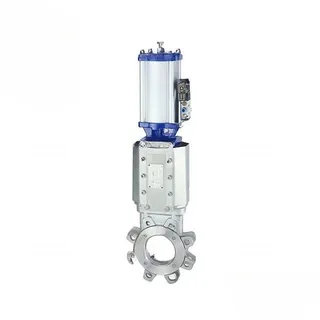Pneumatic Gate Control Valve
The pneumatic gate control valve operates using a pneumatic actuator powered by compressed air to control the movement of its gate valve. The valve features a wedge-shaped or parallel structure, making it ideal for emergency cutoff and discharge applications in gas and liquid pipelines.
Here's how it works: When the valve is in pneumatic operation mode, turning the manual device's small handle to the pneumatic position engages the nut and screw rod for valve operation. Compressed air enters either the upper or lower pipeline of the cylinder: entering from above pushes the piston and rod downwards, opening the valve, while entry from below moves them upwards, closing the valve.
Without an air source, manual operation is possible by adjusting the screw rod and nut. With the cylinder's intake pipes in exhaust mode and the manual handle set accordingly, the valve can be manually operated using the large handwheel. Turning it clockwise closes the valve, counterclockwise opens it.
Introducing compressed air through the upper inlet drives the valve stem downward, closing the valve, while using the lower inlet moves the valve stem upward, opening the valve.
Here's how it works: When the valve is in pneumatic operation mode, turning the manual device's small handle to the pneumatic position engages the nut and screw rod for valve operation. Compressed air enters either the upper or lower pipeline of the cylinder: entering from above pushes the piston and rod downwards, opening the valve, while entry from below moves them upwards, closing the valve.
Without an air source, manual operation is possible by adjusting the screw rod and nut. With the cylinder's intake pipes in exhaust mode and the manual handle set accordingly, the valve can be manually operated using the large handwheel. Turning it clockwise closes the valve, counterclockwise opens it.
Introducing compressed air through the upper inlet drives the valve stem downward, closing the valve, while using the lower inlet moves the valve stem upward, opening the valve.
1 result

